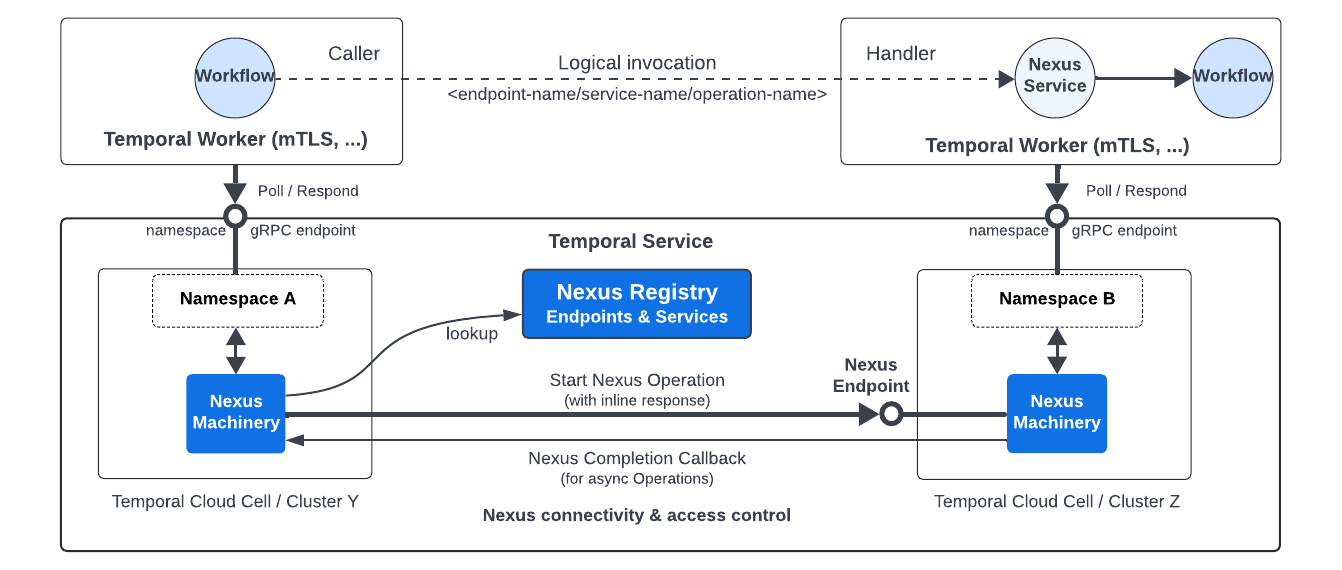Temporal Nexus
Temporal Nexus is now Generally Available for Temporal Cloud and self-hosted deployments.
Temporal Nexus allows you to reliably connect Temporal Applications. It promotes a more modular architecture for sharing a subset of your team's capabilities with well-defined microservice contracts for other teams to use. Nexus was designed with Durable Execution in mind and enables each team to have their own Namespace for improved modularity, security, debugging, and fault isolation.
Connect Temporal Applications
Nexus Services are exposed from a Nexus Endpoint created in the Nexus Registry. Adding a Nexus Endpoint to the Nexus Registry deploys the Endpoint, so it is available at runtime to serve Nexus requests. The Nexus Registry is scoped to an Account in Temporal Cloud and scoped to a Cluster for self-hosted deployments.

Nexus Overview
A Nexus Endpoint is a reverse proxy that decouples the caller from the handler and routes requests to upstream targets. It currently supports routing to a single target Namespace and Task Queue. Nexus Services and Nexus Operations are often registered in the same Worker as the underlying Temporal primitives they abstract.
Nexus connectivity across Namespaces is provided by the Temporal Service. Temporal Cloud supports Nexus connectivity within and across regions and has built-in access controls. Self-hosted Nexus connectivity is supported within a single Cluster and custom Authorizers may be used for access control.
Build and use Nexus Services
Nexus has a familiar programming model to build and use Nexus Services using the Temporal SDK. The Nexus Operation lifecycle supports both synchronous and asynchronous Operations. It is suitable for low-latency and long-running use cases. Nexus Operations can be implemented with Temporal primitives, like Workflows, or execute arbitrary code.
Queue-based Worker architecture
Nexus uses the Temporal queue-based Worker architecture and built-in Nexus Machinery to ensure reliable execution of Nexus Operations. If a Nexus Service is down, a caller Workflow can continue to schedule Nexus Operations and they will be processed when the service is up.
Nexus handler Workers poll the Endpoint's target Namespace and Task Queue for Nexus Tasks to process. Workers authenticate to their Namespace's gRPC endpoint with supported methods including mTLS client certificates or API Keys in Temporal Cloud.

Queue-based Worker architecture
See system interactions for additional detail.
Built-in Nexus Machinery
The built-in Nexus Machinery uses state-machine-based invocation and completion callbacks. It guarantees at-least-once execution, with automatic retries, circuit breaking, rate limiting, and load balancing.
The Nexus Machinery uses Nexus RPC on the wire, a protocol designed with Durable Execution in mind, to support arbitrary-duration Operations that extend beyond a traditional RPC.
For example, when you execute a Nexus Operation in a caller Workflow, a command is sent to Temporal to schedule the Operation, and the Nexus Machinery is responsible for making the Nexus RPC calls on your behalf. This means you don't have to use Nexus RPC directly, only the Temporal SDK along with the Temporal Service.
Multi-level calls
Nexus supports multi-level Nexus calls, for example:
- Workflow A → Nexus Operation 1 → Workflow B → Nexus Operation 2 → Workflow C
Public Preview features
The following Nexus features are currently in Public Preview.